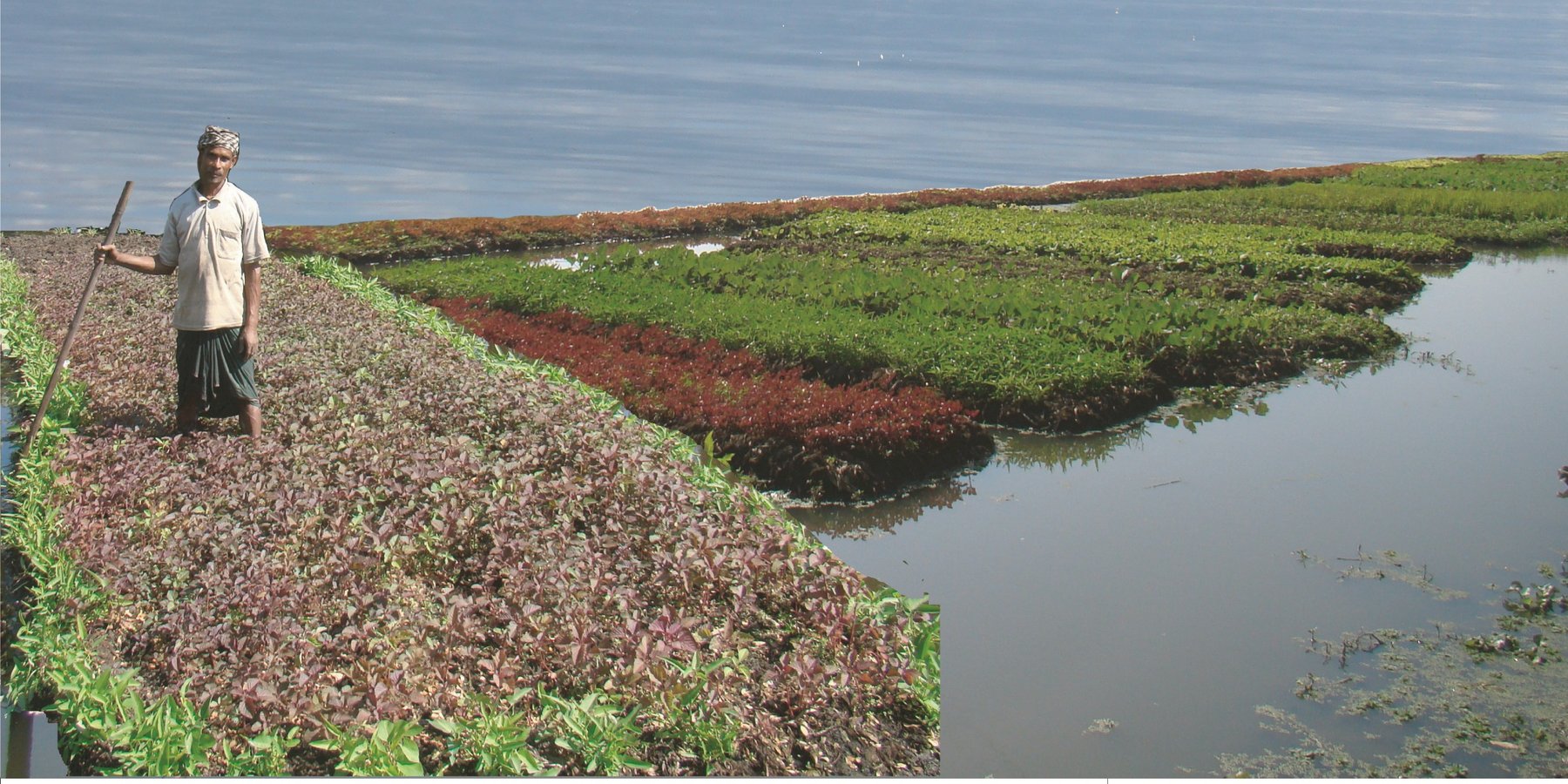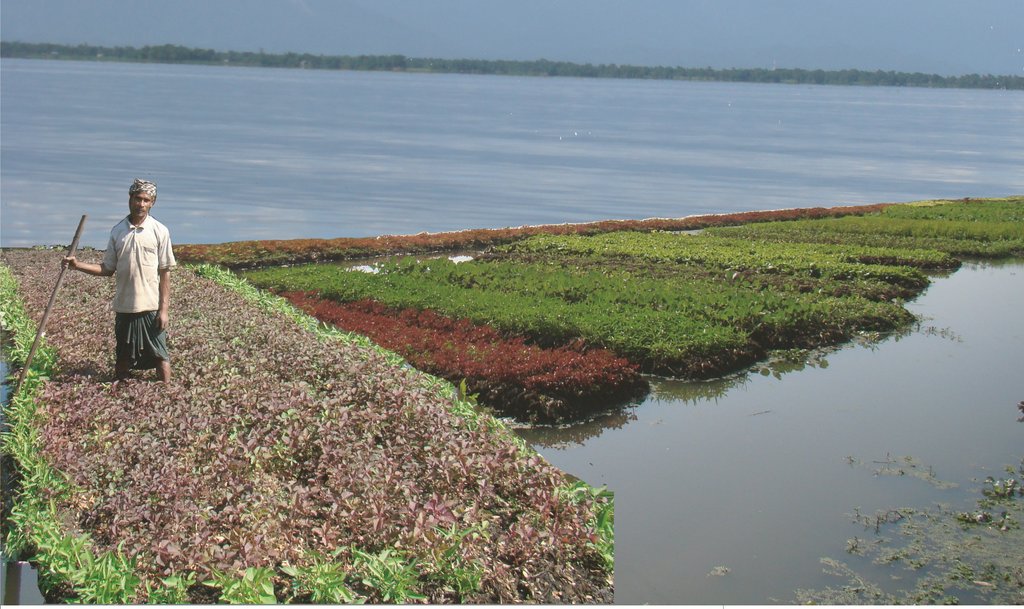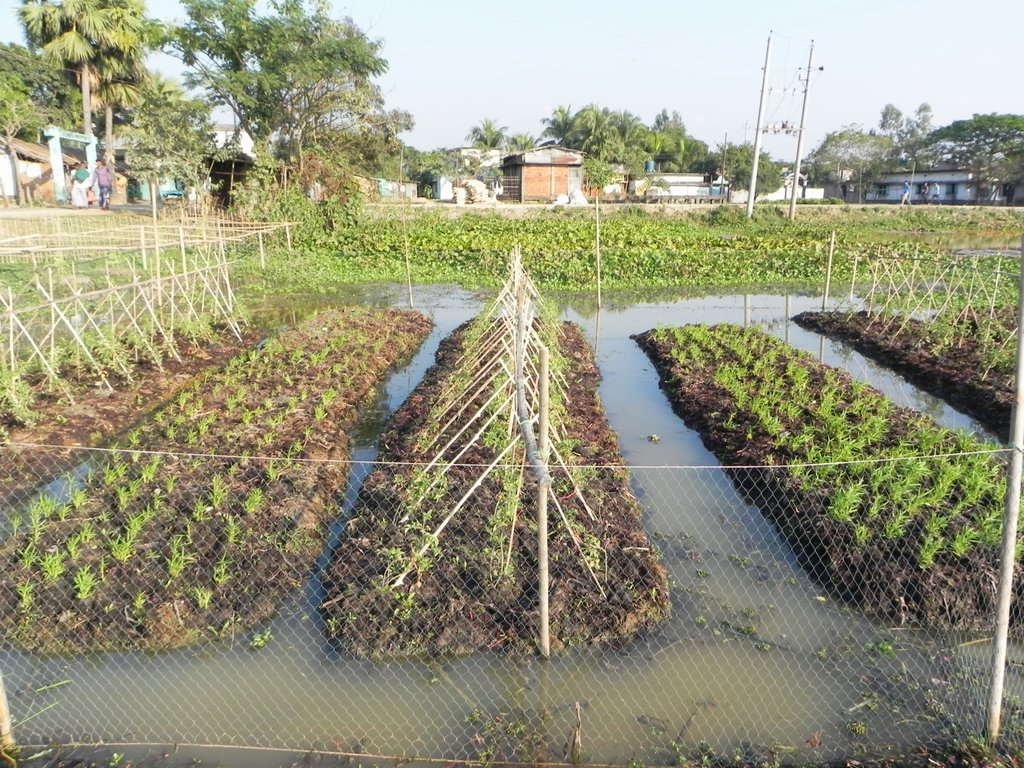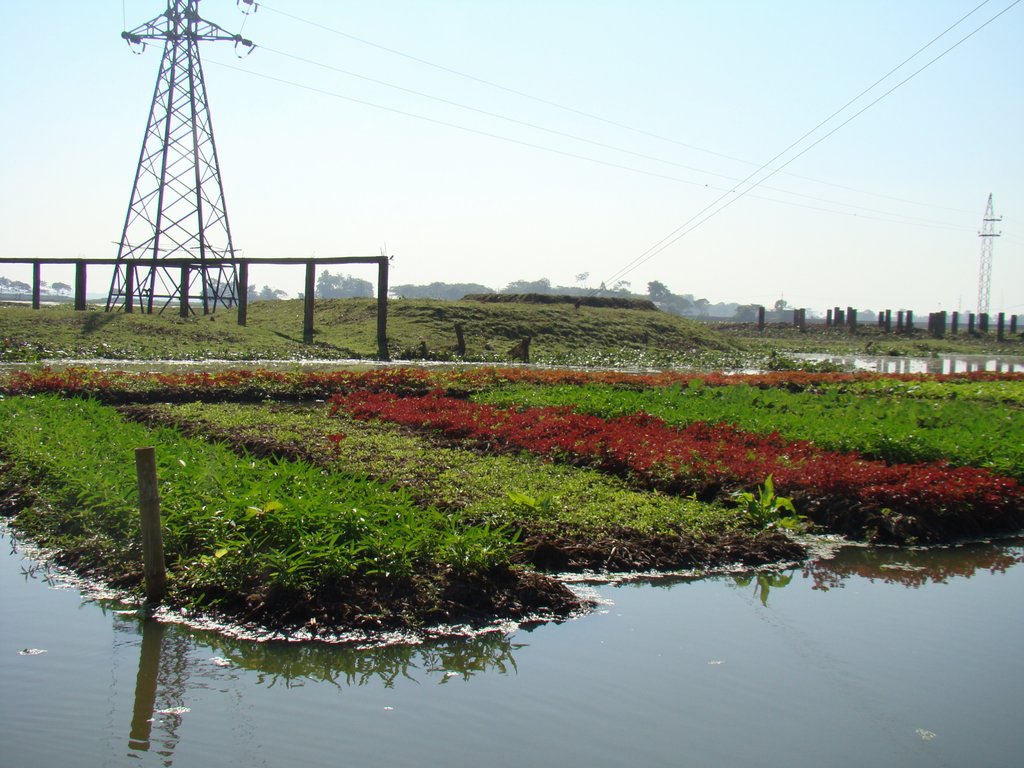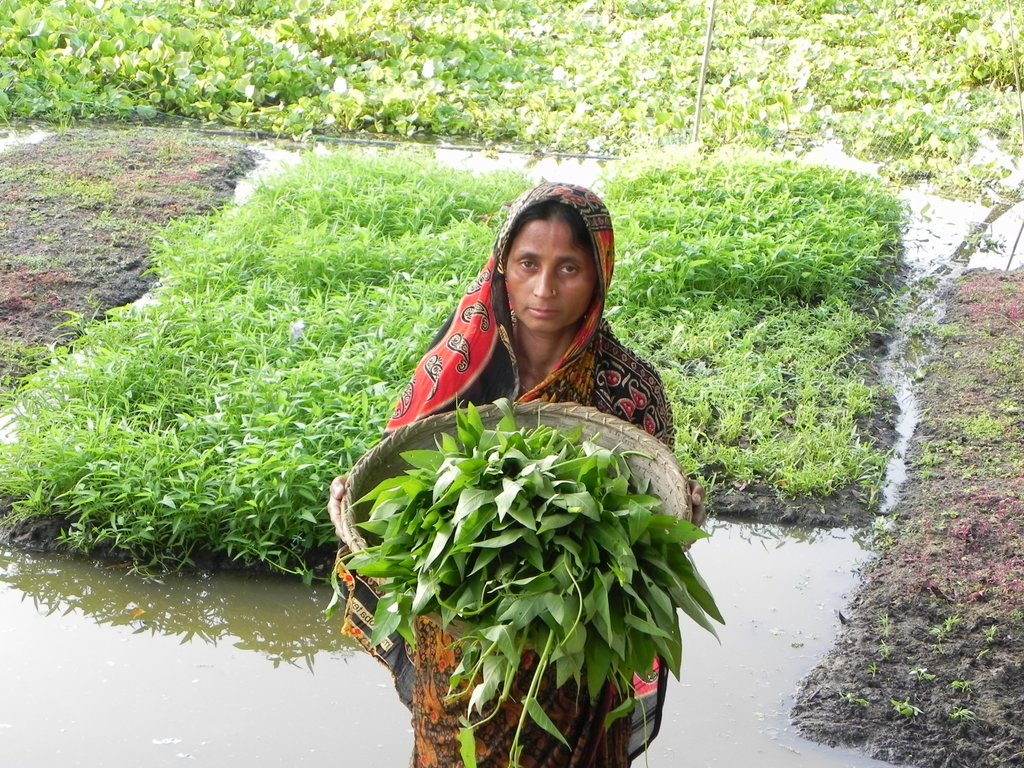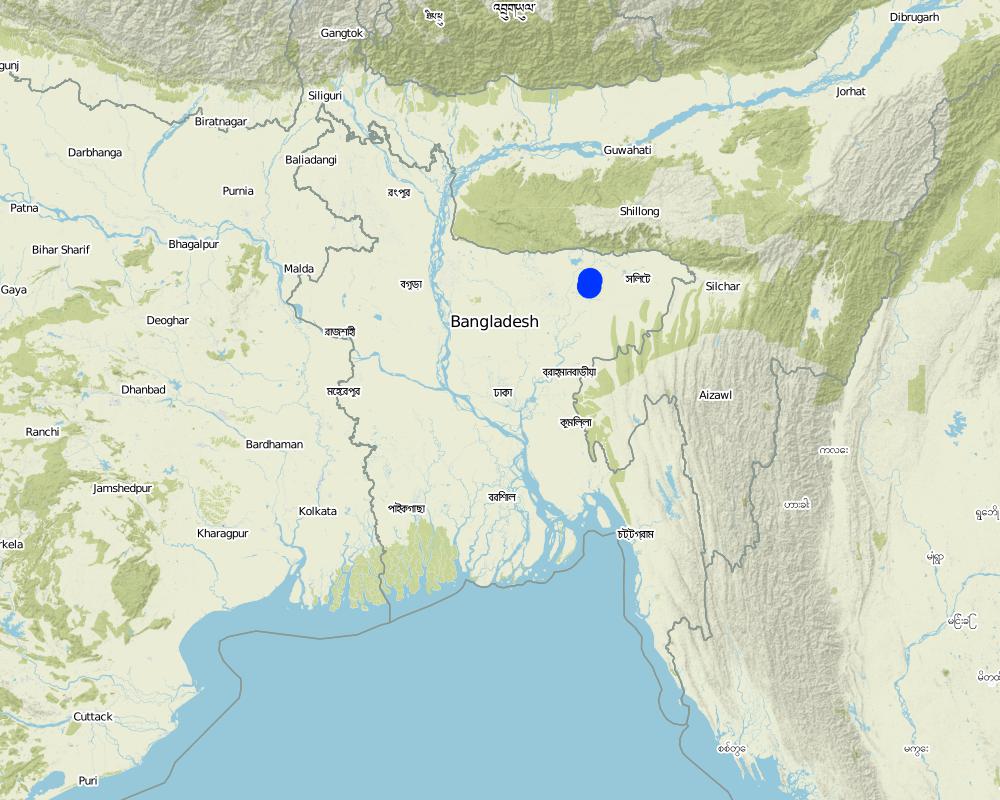Floating Garden [Bangladesh]
- Creation:
- Update:
- Compiler: Shamim Ahamed
- Editor: Eveline Studer
- Reviewers: Alvin Chandra, Alexandra Gavilano
"Baira" or "Dhap", floating bed
technologies_620 - Bangladesh
View sections
Expand all Collapse all1. General information
1.2 Contact details of resource persons and institutions involved in the assessment and documentation of the Technology
Key resource person(s)
SLM specialist:
Hasan Md. Zahid
HELVETAS Swiss Intercooperation
Bangladesh
Name of project which facilitated the documentation/ evaluation of the Technology (if relevant)
Book project: where people and their land are safer - A Compendium of Good Practices in Disaster Risk Reduction (DRR) (where people and their land are safer)Name of the institution(s) which facilitated the documentation/ evaluation of the Technology (if relevant)
HELVETAS (Swiss Intercooperation)1.3 Conditions regarding the use of data documented through WOCAT
The compiler and key resource person(s) accept the conditions regarding the use of data documented through WOCAT:
Yes
1.4 Declaration on sustainability of the described Technology
Is the Technology described here problematic with regard to land degradation, so that it cannot be declared a sustainable land management technology?
No
Comments:
Context specific environmentally friendly technology
2. Description of the SLM Technology
2.1 Short description of the Technology
Definition of the Technology:
Floating Garden is a traditional technology, practiced in the southern parts of Bangladesh locally called “Baira” or “Dhap”. The technology allows producing crops, vegetables and seedlings in areas where farming land is scarce and where the land is flodded or water logged for more than six months in a year.
2.2 Detailed description of the Technology
Description:
Floating gardensa are a traditional practice in south central districts of Bangladesh since long time, and has been promoted by government extension agency and development organizations in different parts of the country with technical improvements. With this technology, crops (mainly vegetables) are cultivated on floating garden beds in areas where the land inundated for more than six months in a year.
Establishment:
The basic input and main raw material to prepare the floating garden bed are water hyacinths (Eichhornia crassipes). In some cases bamboo sticks are also used to make the floating beds more resistant. The floating gardens are of different size, with a standard size per bed during preparation of 1.5 - 1.8 meter wide, 10 -11 meter long and 1 - 1.3 meter above water level. However, considering local context- such as wave action, size of water body, presence of a wetland - the bed size may vary, also depending on whether compost is added on the top. The establishment of the floating gardens are very cheap in terms of raw material and require mainly human manual labour for its establishment, without material costs for maintenance.
The garden can be used for two purposes: for vegetable production and for vegetable seedling production.
In water logged areas (where water remains for the whole year) floating beds are mainly used for vegetable production. Almost any type of vegetables can be grown in the floating bed. Production of leafy vegetables proofed to be most profitable. In addition, all types of vegetable seedlings and rice seedlings can produced in floating garden based on demand. In other areas, which are only inundated temporarily, floating garden can be used for both vegetable and seedling production. In this second case seedlings can be transfered from the garden to the fields on the main land immediately after receding of the water. This practice can save 2 to 3 weeks time of vegetable or rice production in winter season. This is a crucial advantage considering the trend to shorter growing periods due to unpredictable early spring rains.
A key advantage of floating gardening is the fact that heavy rainfalls usually do not have any negative effect on culture of the floating gardens, which are a highly effective and beneficial risk reduction and climate change mitigation technology. Floating gardens can further contribute to food security and improved nutrition for poor households, and it is a source for additional income by making use of cheap and abundant local input resources. Different NGOs improved and promoted this technology in north-west and north-east parts of Bangladesh since 2000. Since 2011 also the public agricultural extension agencies promote this technology.
As an overall goal this technology aims at protecting people’s assets for agricultural production from damages due to seasonal floods and provide options for alternative income resources. The floating garden technology is designed as measure to protect effectively from yearly floods. It might not be robust enough for extreme events with heavy storms and waves. Smaller repairing can be done by the owners themselves. In case of major damages the beds can be replaced by new ones, since the investment costs are very low. In the shallow areas the floating beds may become ordinary garden beds or fields during dry season.
2.3 Photos of the Technology
2.4 Videos of the Technology
Comments, short description:
This video was developed for the capitalization of practical experience and instructive training materials. The short movie describes step by step the establishment and the benefits of the floating gardens. In a short interview governmental and other local partners share their positive experience of the technology and describe how the technology is mainstreamed by Government agencies.
The video is available online with following link: https://youtu.be/AK_qTm2pUsw
Date:
29/02/2012
Location:
Sunamganj, Bangladesh
Name of videographer:
HELVETAS Swiss Intercooperation
Comments, short description:
The video documentary was prepared to capitalise and diseminate the experience of the Floating Gardens as an innovative technology for vegetable cultivation in wetlands.
Date:
01/06/2012
Location:
Sunamganj, Bangladesh
Name of videographer:
HELVETAS Swiss Intercoopartion
2.5 Country/ region/ locations where the Technology has been applied and which are covered by this assessment
Country:
Bangladesh
Region/ State/ Province:
Sylhet division, Sunamganj district
Further specification of location:
Paschim Pagla, Patharia and Shimulbak unions under South Sunamganj sub-district, Charnarchar and Rajanagar unions under Derai sub-district
Specify the spread of the Technology:
- applied at specific points/ concentrated on a small area
Comments:
More than 1000 floating beds have been prepared in 8 sub-districts of Sunamganj district in northeastern Bangladesh and documented accordingly. HELVETAS supported government agencies (District Administration and Department of Agricultural Extension-DAE) to document and promote the technology further.
Map
×2.6 Date of implementation
If precise year is not known, indicate approximate date:
- less than 10 years ago (recently)
2.7 Introduction of the Technology
Specify how the Technology was introduced:
- through projects/ external interventions
Comments (type of project, etc.):
The technology was first piloted through implementation of “Livelihoods, Empowerment and Agroforestry (LEAF)” project. Later on, the technology was expanded through implementation of “Agricultural Innovation for Eliminating Extreme Poverty” (AIEEP 2009-2012) and through Unnoti -Prosperity in Haor project (2013-2016).
3. Classification of the SLM Technology
3.1 Main purpose(s) of the Technology
- improve production
- reduce risk of disasters
- adapt to climate change/ extremes and its impacts
- create beneficial economic impact
- create beneficial social impact
- improve household food security / nutrition
3.2 Current land use type(s) where the Technology is applied

Cropland
- Annual cropping
Annual cropping - Specify crops:
- vegetables - leafy vegetables (salads, cabbage, spinach, other)
- seedlings
Number of growing seasons per year:
- 2
Specify:
Winter and early Summer

Waterways, waterbodies, wetlands
- Swamps, wetlands
Main products/ services:
Vegetable, Seedling and Fishes
3.3 Has land use changed due to the implementation of the Technology?
Comments:
earlier these wetland areas were mainly fallow (not used for any productive purpose). During monsoon season, the waterbodies naturally count on fish reserves, which are captures by local farmers including landless poor. Water hyacinth of these wetlands were partially used as fodder, though most of it was decomposed naturally without use.
3.4 Water supply
other (e.g. post-flooding):
- post-flooding
Comments:
Floating gardens are prepared on the water body, hence can absorb sufficient water without additional irrigation.
3.5 SLM group to which the Technology belongs
- improved ground/ vegetation cover
- wetland protection/ management
- home gardens
3.6 SLM measures comprising the Technology

agronomic measures
- A5: Seed management, improved varieties

structural measures
- S11: Others

management measures
- M1: Change of land use type
Comments:
floating beds, which are adapted to changing water levels (floods).
change of land/water management from pure wetlands to gardens.
3.7 Main types of land degradation addressed by the Technology

water degradation
- Hs: change in quantity of surface water
Comments:
More frequent and severe seasonal floodings
3.8 Prevention, reduction, or restoration of land degradation
Specify the goal of the Technology with regard to land degradation:
- reduce land degradation
- adapt to land degradation
Comments:
The technology is used to adapt to natural seasonal flooding, to prevent damages caused by floods by using wet lands for crop production.
4. Technical specifications, implementation activities, inputs, and costs
4.1 Technical drawing of the Technology
Technical specifications (related to technical drawing):
• Dimensions: The floating beds are of different size. Standard size at the time of preparation 1.5 - 1.8 meter wide, 10-11 meter long and 1.0-1.3 meter height.
• Floating beds should not cover more than 30% area of the respective water body (wetland area) in order to keep enabling environment for other aquatic resources (e.g. fishes).
• Construction material used: The basic and main ingredient/material for the preparation of the floating garden are water hyacinths (Eichhornia crassipes). In some cases, bamboo sticks are also used to increase its resistance. If available, composts may be applied on the top of floating beds, though not compulsory.
Author:
Shakila Chayan
Date:
12/10/2016
4.2 General information regarding the calculation of inputs and costs
Specify how costs and inputs were calculated:
- per Technology area
Indicate size and area unit:
1 decimal for 5 floating beds
If using a local area unit, indicate conversion factor to one hectare (e.g. 1 ha = 2.47 acres): 1 ha =:
1 hectare = 247 decimals
other/ national currency (specify):
BDT
Indicate average wage cost of hired labour per day:
1 man-day cost BDT 300 (USD 3.85)
4.3 Establishment activities
| Activity | Timing (season) | |
|---|---|---|
| 1. | Bed preparation (by hired labour) | August-September |
| 2. | Seeding, care and maintenance, harvesting | September-March |
Comments:
After full harvesting of vegetable in March, the bed (decomposed water hyacinth) can be used as organic compost for other crops in cultivable land.
4.4 Costs and inputs needed for establishment
| Specify input | Unit | Quantity | Costs per Unit | Total costs per input | % of costs borne by land users | |
|---|---|---|---|---|---|---|
| Labour | Hired labour cost for bed establishment | persons day | 10.0 | 300.0 | 3000.0 | |
| Labour | Bed management cost (seeing, care, harvest ect.) | persons day | 90.0 | 300.0 | 27000.0 | 100.0 |
| Plant material | Seeds per year | kg | 25.0 | 100.0 | 2500.0 | 100.0 |
| Construction material | Bamboo | bamboo quantity | 2.0 | 100.0 | 200.0 | |
| Construction material | Rope and lubricants | lumpsum | 1.0 | 250.0 | 250.0 | |
| Total costs for establishment of the Technology | 32950.0 | |||||
| Total costs for establishment of the Technology in USD | 32950.0 | |||||
4.5 Maintenance/ recurrent activities
Comments:
No maintenance required
4.6 Costs and inputs needed for maintenance/ recurrent activities (per year)
Comments:
No specific maintenance costs during the year/season required. Small repairments are part of the labour costs of agronomic mesures to be done in paralele with care work.
4.7 Most important factors affecting the costs
Describe the most determinate factors affecting the costs:
In case the inputs, mainly water hyacinths, are not available at the selected sites, this increases the material and/or labour costs for hyacinths to be transported from distant locations.
All indicated costs refer to yearly costs, since the beds ususally have to be restablished every year.
5. Natural and human environment
5.1 Climate
Annual rainfall
- < 250 mm
- 251-500 mm
- 501-750 mm
- 751-1,000 mm
- 1,001-1,500 mm
- 1,501-2,000 mm
- 2,001-3,000 mm
- 3,001-4,000 mm
- > 4,000 mm
Specify average annual rainfall (if known), in mm:
3365.00
Specifications/ comments on rainfall:
The driest month is December, with 6 mm of rain. The greatest amount of precipitation occurs in June, with an average of 712 mm.
Indicate the name of the reference meteorological station considered:
Sunamganj, Bangladesh (data source: www.en.climate-data.org)
Agro-climatic zone
- humid
The average annual temperature is 25.0 °C in Sunamganj.
5.2 Topography
Slopes on average:
- flat (0-2%)
- gentle (3-5%)
- moderate (6-10%)
- rolling (11-15%)
- hilly (16-30%)
- steep (31-60%)
- very steep (>60%)
Landforms:
- plateau/plains
- ridges
- mountain slopes
- hill slopes
- footslopes
- valley floors
Altitudinal zone:
- 0-100 m a.s.l.
- 101-500 m a.s.l.
- 501-1,000 m a.s.l.
- 1,001-1,500 m a.s.l.
- 1,501-2,000 m a.s.l.
- 2,001-2,500 m a.s.l.
- 2,501-3,000 m a.s.l.
- 3,001-4,000 m a.s.l.
- > 4,000 m a.s.l.
Indicate if the Technology is specifically applied in:
- concave situations
5.3 Soils
If available, attach full soil description or specify the available information, e.g. soil type, soil PH/ acidity, Cation Exchange Capacity, nitrogen, salinity etc.
Not applicable for this technology as floating bed prepare on surface of water body
5.4 Water availability and quality
Ground water table:
on surface
Availability of surface water:
excess
Water quality (untreated):
for agricultural use only (irrigation)
Is water salinity a problem?
No
Is flooding of the area occurring?
Yes
Regularity:
frequently
Comments and further specifications on water quality and quantity:
Each year seasonal monsoon flooding. However, early flash (pre monsoon flood) occur only every 3 years.
5.5 Biodiversity
Species diversity:
- medium
Habitat diversity:
- medium
Comments and further specifications on biodiversity:
Water bodies are rich with diverse aquatic organisms
5.6 Characteristics of land users applying the Technology
Sedentary or nomadic:
- Sedentary
Market orientation of production system:
- mixed (subsistence/ commercial)
Off-farm income:
- 10-50% of all income
Relative level of wealth:
- very poor
- poor
Individuals or groups:
- individual/ household
- groups/ community
Level of mechanization:
- manual work
Gender:
- women
- men
Age of land users:
- youth
- middle-aged
5.7 Average area of land used by land users applying the Technology
- < 0.5 ha
- 0.5-1 ha
- 1-2 ha
- 2-5 ha
- 5-15 ha
- 15-50 ha
- 50-100 ha
- 100-500 ha
- 500-1,000 ha
- 1,000-10,000 ha
- > 10,000 ha
Is this considered small-, medium- or large-scale (referring to local context)?
- small-scale
5.8 Land ownership, land use rights, and water use rights
Water use rights:
- open access (unorganized)
- individual
Comments:
The farmers establish floating gardens in public water body and in private water body (with verbal agreement of water body owners).
5.9 Access to services and infrastructure
health:
- poor
- moderate
- good
education:
- poor
- moderate
- good
technical assistance:
- poor
- moderate
- good
employment (e.g. off-farm):
- poor
- moderate
- good
markets:
- poor
- moderate
- good
energy:
- poor
- moderate
- good
roads and transport:
- poor
- moderate
- good
drinking water and sanitation:
- poor
- moderate
- good
financial services:
- poor
- moderate
- good
6. Impacts and concluding statements
6.1 On-site impacts the Technology has shown
Socio-economic impacts
Production
crop production
Comments/ specify:
crop production during rainy season becomes possible
production area
Comments/ specify:
innundated fallow water bodies can be used for food production, which increases surface for production.
Income and costs
farm income
Comments/ specify:
People produce vegetable/seedlings and increase their cash income through selling of the production surplus in the market. It also provide food and additional nutrition support to the farm family. Consequently, poor farmer families increase their resilience to food insecurity and income fluctuation.
diversity of income sources
Comments/ specify:
Additional income for floating gardeners, which is particularly valuable for poor i.e. landless people.
economic disparities
Quantity before SLM:
0
Quantity after SLM:
1
workload
Comments/ specify:
slight but no significant increase in workload for bed preparation, care and harvesting
Socio-cultural impacts
food security/ self-sufficiency
Comments/ specify:
Vegetable production for home consumption contribute to households food security, which is particularly critical during rainiy season.
health situation
Comments/ specify:
Improved nutrition through household consumption of own vegetable production.
land use/ water rights
Comments/ specify:
People establish floating garden on public water bodies or individual water bodies, based on a (verbal) agreement and regulated by a free or rent.
cultural opportunities
Comments/ specify:
Increase aesthetic view of wetlands, water becomes valuable productive surface with plants and flowers.
SLM/ land degradation knowledge
Comments/ specify:
Increased knowledge on disaster risk reduction technology, based on local resources and capacities adjusted to the situation of socially and economically disadvantaged groups.
situation of socially and economically disadvantaged groups
Comments/ specify:
Its an simple "self-help" technology, which proveds new income options particularly for most vulnerable. It can be replicated by disadvantaged groups them-selfs landless and increases cohesion among the poor and very poor community members.
Ecological impacts
Biodiversity: vegetation, animals
Vegetation cover
Comments/ specify:
floating gardens increase vegetation coverage on the water surface
biomass/ above ground C
Comments/ specify:
the material of old floating gardens, usualy at the end of the rainy season, are used as compost/ fertiliser for crop land.
animal diversity
Comments/ specify:
With the floating gardens there are less water hyacinths spread over the surface, which increases sunlight and oxygen on the water. Hence, this contributes to good conditions for the growth of fish and other aquatic resources.
Climate and disaster risk reduction
flood impacts
Comments/ specify:
Negative impacts due to floods, such as damages and limited production can be substantially reduced with this technology, which increases production and income during flooding period.
6.2 Off-site impacts the Technology has shown
damage on neighbours' fields
Quantity before SLM:
0
Quantity after SLM:
1
Comments/ specify:
reduce/protect wave action and decrease soil erosion of the adjacent/raised land.
damage by wave erosion
Comments/ specify:
The floating gardens reduce wave erosion on neighbours' fields, since the beds protect adjacent land and assets from soil erosion.
Specify assessment of off-site impacts (measurements):
No specific research have been made on off-site and environmental impact of the floating garden technology.
6.3 Exposure and sensitivity of the Technology to gradual climate change and climate-related extremes/ disasters (as perceived by land users)
Climate-related extremes (disasters)
Hydrological disasters
| How does the Technology cope with it? | |
|---|---|
| general (river) flood | well |
| flash flood | very well |
Other climate-related extremes (disasters)
| other (specify) | How does the Technology cope with it? |
|---|---|
| increasingly unpredictable start and duration of monsoon/rainy season, floods | moderately |
Other climate-related consequences
Other climate-related consequences
| How does the Technology cope with it? | |
|---|---|
| extended growing period | well |
Comments:
with the effect of climate change monsoon have become more impredictable: starting sooner, ending later.
The techology allows to plant and grow seedlings already before the end of rainy season, and can therefor mantain or even extend the growing period.
6.4 Cost-benefit analysis
How do the benefits compare with the establishment costs (from land users’ perspective)?
Short-term returns:
positive
Long-term returns:
slightly positive
How do the benefits compare with the maintenance/ recurrent costs (from land users' perspective)?
Short-term returns:
very positive
Long-term returns:
very positive
Comments:
Considering only one season - particualrly for intensive raining seasons - the gardens have positive benefits.
Considering a longer time period with less intensive rainy seasons, the fact that the bed ususally have to be reestablished every year might require an important work from a land user's perspective (therefore rate with slightly less benefits)
6.5 Adoption of the Technology
- 1-10%
If available, quantify (no. of households and/ or area covered):
about 1000
Of all those who have adopted the Technology, how many did so spontaneously, i.e. without receiving any material incentives/ payments?
- 11-50%
6.6 Adaptation
Has the Technology been modified recently to adapt to changing conditions?
No
6.7 Strengths/ advantages/ opportunities of the Technology
| Strengths/ advantages/ opportunities in the land user’s view |
|---|
| In the Haor area’ (local wetland ecosystem flooded during monsoon season) water hyacinths are naturally abundant. These are the basis and substrate for floating gardens. Hence, the technology makes use of local plants as resorces, as substrate of the floating garden. If required, floating bed can easily moved from one location to another. After preparation of the bed, no additional hard labour is required. |
| There is hardly pest infestation, therefore no use of pesticides is required. |
| After final harvest, the beds are used as organic compost for the fields. Further, the farmers either can sell or use the substrate of the garden as compost. |
| This simple technology and can easily be replicated. |
| During heavy rainfalls and storms, the crop are not damaged by floods since on a floating surface. |
| Strengths/ advantages/ opportunities in the compiler’s or other key resource person’s view |
|---|
|
Through this technology, crops can be produced on the water surface. The usually abundant water hyacinth are used as a productive resource, which increases the surface for crop production. In contexts, such as Bangladesh, where land resources are scarce this opens production options in public/abundant water bodies for landless farmers, who can earn money within a short period and with little investment. |
|
The production for home consumption improves nutrition, contributes to food security and surplus is sold at the market, which contribute to the income of poor households. The technology is useful for increasing production for home consumption and market. |
6.8 Weaknesses/ disadvantages/ risks of the Technology and ways of overcoming them
| Weaknesses/ disadvantages/ risks in the land user’s view | How can they be overcome? |
|---|---|
| In some cases there are water leeches available in the water body. Therefore, people become afraid of preparing floating beds. | People polish diesel/kerosene oil in their body before preparation of floating beds to protect them from attack of leeches. |
|
In some cases, water hyacinths are not available locally, consequently farmers face difficulties to prepare floating beds in distant places. Further challenges are the guarding/security of the gardens, the time consuming establishment of the beds. |
Introduce and prepare floating gardens by supporting whole groups instead of individual famers. |
| Wave action and local streams may drift away the floating beds | Use bamboo pole to fix floating beds and prevent that they are floating away. |
| Weaknesses/ disadvantages/ risks in the compiler’s or other key resource person’s view | How can they be overcome? |
|---|---|
| Non-availability of adequate quantity of water hyacinth in same place every year. | Prepare bed in the places where water hyacinth are available and then move the beds in to the desired locations. |
| Due to heavy wave action or heavy water flow, floating beds could be broken/destroyed. | Prepare small size beds. |
| Lack of awareness and willingness of farmers to practice this technology. | Organise meeting, training, demonstration, and learning visit. |
7. References and links
7.1 Methods/ sources of information
- field visits, field surveys
10 times field visits and 28 informants.
- interviews with land users
25
- interviews with SLM specialists/ experts
4
When were the data compiled (in the field)?
05/10/2016
7.2 References to available publications
Title, author, year, ISBN:
A learning documentary on Floating Vegetable Garden, HELVETAS Swiss Intercooperation, March-2012, ISBN: 978-984-33-5313-9
Available from where? Costs?
https://youtu.be/AK_qTm2pUsw
Title, author, year, ISBN:
Innovative Vegetable Cultivation, HELVETAS Swiss Intercooperation, 2012
Available from where? Costs?
https://youtu.be/lhiraDjPymU
Title, author, year, ISBN:
Piloting Schemes Systematic Integration of DRR in LEAF - December 2010
Available from where? Costs?
https://assets.helvetas.org/downloads/drr_capex.pdf
7.3 Links to relevant online information
Title/ description:
A learning documentary on Floating Vegetable Garden, HELVETAS Swiss Intercooperation, March-2012, ISBN: 978-984-33-5313-9
URL:
https://youtu.be/AK_qTm2pUsw
Title/ description:
Innovative Vegetable Cultivation, HELVETAS Swiss Intercooperation, 2012
URL:
https://youtu.be/lhiraDjPymU
Title/ description:
Islam and Atkins, 2007. Indigenous floating cultivation: a sustainable agricultural practice in the wetlands of Bangladesh. Development in Practice 17:130-136.
URL:
https://www.jstor.org/stable/25548185?seq=1#page_scan_tab_contents
Title/ description:
Irfanullah et al., 2008. Introduction of floating gardening in the northeastern wetlands of Bangladesh for nutritional security and sustainable livelihood. Renewable Agriculture and Food Systems 23:89-96
URL:
http://nopr.niscair.res.in/bitstream/123456789/11064/1/IJTK%2010(1)%2031-38.pdf
Title/ description:
Irfanullah et al., 2011. Floating gardening in Bangladesh: a means to rebuild lives after devastating flood. Indian Journal of Traditional Knowledge 10:31-38.
URL:
http://nopr.niscair.res.in/bitstream/123456789/11064/1/IJTK%2010(1)%2031-38.pdf
Title/ description:
Irfanullah, 2013. Floating Gardening: a local lad becoming a climate celebrity? Clean Slate 88:26-27.
URL:
http://floodresilience.net/solutions/item/floating-gardening-a-local-lad-becoming-a-climate-celebrity
Links and modules
Expand all Collapse allLinks
No links
Modules
No modules


